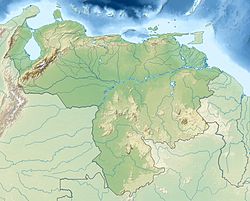Chimantá Massif
| Chimantá Massif | |
|---|---|
| Highest point | |
Bolívar, Venezuela | |
The Chimantá Massif is a
cave systems, including the world's largest known quartzite cave, Cueva Charles Brewer, named after discoverer Charles Brewer-Carías.[5][6][7] The processes behind their speleogenesis are the subject of some debate.[8][9][10]
The isolated southern peaks of Angasima-tepui and Upuigma-tepui are sometimes considered part of the Chimantá Massif.[4][11]
Tepuis
The major tepuis of the northern and southern parts of the Chimantá Massif are listed below. Coordinates given correspond to the approximate centre points of the tepui summit plateaus. Unless otherwise indicated, all information in the tables is sourced from Flora of the Venezuelan Guayana.[3]
Northern group
| Name | Coordinates | Maximum elevation | Summit area |
|---|---|---|---|
| Abacapá-tepui | 05°11′04″N 62°17′51″W / 5.18444°N 62.29750°W | 2,400 m (7,900 ft) | 28.13 km2 (10.86 sq mi) |
| Agparamán-tepui | 05°14′50″N 62°12′29″W / 5.24722°N 62.20806°W | 2,400 m (7,900 ft) | 22.5 km2 (8.7 sq mi) |
| Apacará-tepui | 05°19′12″N 62°13′43″W / 5.32000°N 62.22861°W | 2,450 m (8,040 ft) | 173.12 km2 (66.84 sq mi) |
| Chimantá-tepui | 05°16′37″N 62°07′52″W / 5.27694°N 62.13111°W | 2,550 m (8,370 ft) | 93.75 km2 (36.20 sq mi) |
| Murey-tepui | 05°22′36″N 62°05′36″W / 5.37667°N 62.09333°W | 2,698 m (8,852 ft)[1] | 51.25 km2 (19.79 sq mi) |
| Tirepón-tepui | 05°22′04″N 62°01′12″W / 5.36778°N 62.02000°W | ±2,600 m (8,500 ft) | 8.75 km2 (3.38 sq mi) |
| Toronó-tepui | 05°12′42″N 62°10′33″W / 5.21167°N 62.17583°W | 2,500 m (8,200 ft) | 59.38 km2 (22.93 sq mi) |
An additional plateau, Sarvén-tepui, may be distinguished to the east of Chimantá-tepui (05°17′55″N 62°04′17″W / 5.29861°N 62.07139°W).[3]
Southern group
| Name | Coordinates | Maximum elevation | Summit area |
|---|---|---|---|
| Acopán-tepui | 05°10′55″N 62°02′42″W / 5.18194°N 62.04500°W | 2,200 m (7,200 ft) | 92.5 km2 (35.7 sq mi) |
| Amurí-tepui | 05°08′57″N 62°07′16″W / 5.14917°N 62.12111°W | 2,200 m (7,200 ft) | 36.88 km2 (14.24 sq mi) |
| Churí-tepui | 05°15′12″N 62°00′41″W / 5.25333°N 62.01139°W | 2,500 m (8,200 ft) | 47.5 km2 (18.3 sq mi) |
See also
References
- ^
- ^ a b c d e Huber, O. (1995). Geographical and physical features. In: P.E. Berry, B.K. Holst & K. Yatskievych (eds.) Flora of the Venezuelan Guayana. Volume 1. Introduction. Missouri Botanical Garden Press, St. Louis. pp. 1–61.
- ^ a b (in Spanish) Torres, I.N. & D.D. Martín (November 2007). "Informe Final de la Evaluación del Parque Nacional Canaima, Venezuela, como Sitio de Patrimonio Natural de la Humanidad" (PDF). Mejorando Nuestra Herencia.
- ^ (in Spanish) Brewer-Carías, C. (2011). El Sistema Charles Brewer: la cueva de cuarcita más grande del mundo. Río Verde 4: 67–84.
- ^ (in Spanish) Brewer-Carías, C. (2010). El origen de los tepuyes: los hijos de las estrellas. Río Verde 3: 54–69.
- ^ (in Spanish) Adankasima Archived 2012-04-15 at the Wayback Machine. ClimTepuyes.
Further reading
- Barrio-Amorós, C.L., J. Mesa, C. Brewer-Carías & R.W. McDiarmid (25 May 2010). A new Pristimantis (Anura, Terrarana, Strabomantidae) from Churi-tepui in the Chimanta Massif, Venezuelan Guayana. Zootaxa 2483: 35–44.
- (in Spanish) Delascio-Chitty, F. & C. Brewer–Carías (February 2006). Notas florísticas del Churi–tepuy, Estado Bolívar, Venezuela. [Floristic notes of the Churí-tepuy, State of Bolívar, Venezuela.] In: I Congreso Internacional de Biodiversidad del Escudo Guayanés: Programa y Libro de Resúmenes.[permanent dead link] Universidad Nacional Experimental de Guayana, Puerto Ordaz. p. 141.
- Derka, T. & P. Fedor (21 October 2010). Hydrolutos breweri sp. n., a new aquatic Lutosini species (Orthoptera: Anostostomatidae) from Churí-tepui (Chimantá Massif, Venezuela). Zootaxa 2653: 51–59.
- Jaffe, K., J. Lattke & R. Perez-Hernández (January–June 1993). Ants on the tepuies of the Guiana Shield: a zoogeographic study. Ecotropicos 6(1): 21–28.
- (in Spanish) Huber, O. (ed.) (1992). El Macizo del Chimantá, Escudo de Guayana, Venezuela. Un ensayo ecológico tepuyano. Oscar Todtmann Editores, Caracas. ISBN 980-6028-16-3
- Kodada, J., T. Derka & F. Čiampor, Jr. (6 March 2012). Description of Jolyelmis spangleri a new species from Churí-tepui (Chimantá Massif, Venezuela), with a description of the larva of J. spangleri and J. reitmaieri (Insecta: Coleoptera: Elmidae). Zootaxa 3223: 1–23.
- Kok, P.J.R., R.D. MacCulloch, D.B. Means, K. Roelants, I. Van Bocxlaer & F. Bossuyt (7 August 2012). "Low genetic diversity in tepui summit vertebrates" (PDF). Archived from the original (PDF) on 2013-06-05. Retrieved 2013-03-07. Current Biology 22(15): R589–R590. ]
- (in Spanish) La Cruz, L. (February–April 2010). Iván Calderon y su mundo vertical. Río Verde 1: 98–115.

